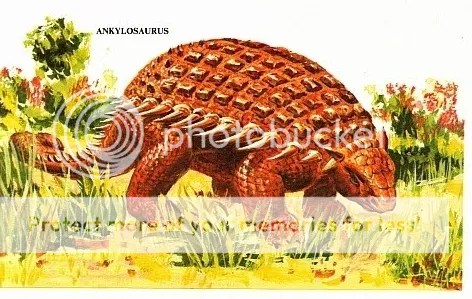(This blog is not for profit. All copyrighted images belong to their respective owners and are used for review. New to the blog? Start on the introduction.)



If you’ve been reading my blog for some amount of time you may know that one of my pet peeves when it comes to reconstructing dinosaurs is inaccurate ankylosaurs. But the unfortunate thing is that Ankylosaurus is actually known from very few remains, so we aren’t exactly sure what the complete picture of this dinosaur looked like. We can make educated guesses from what we do have and from more complete related species, and there are also things we know for a FACT these creatures didn’t have. However, so many artists will add these features to their Ankylosaurus reconstructions, even today. The only reason I get so angry about this is because it continues to happen, and it isn’t getting shunned like other paleo art tropes. We are all ganging up on people who draw featherless raptors while things like this get away unscathed! And I think it’s time it stopped.
At first, it was certainly understandable that reconstructions of this dinosaur were rather strange, given that the only fossils we had of this creature was it’s skull, some armor scutes and later a tail club. One of the earlier illustrations giving a speculative look of the creature was this.

For an early attempt, especially with little to work with, it doesn’t look that bad. However, things will get much worse.
The story of how Ankylosaurus restorations became so inaccurate is a bumpy one. It all starts with a little dinosaur called Palaeoscincus. I wouldn’t be surprised if you’ve never heard of it, but you may be familiar with that name if you’ve had old dinosaur books. It’s one of those dinosaurs that was only known from teeth, but thanks to older speculative illustrations, it was given new life in mid 20th century dinosaur books, much like Trachodon. In the early 1900’s, this armor was attributed to Palaeoscincus.

However, this armor was later assigned to the currently more famous Edmontonia.

Edmontonia was a member of a group of armored dinosaurs closely related to ankylosaurs called nodosaurs. Only nodosaurs are known to have giant spikes coming out of the sides of their shoulders; no ankylosaur is known to have this trait. However, because this armor was once attributed to Palaeoscincus, you can see a lot of old paleo-art depicting this dinosaur that we only know from teeth with nodosaur like spikes on it’s sides and an ankylosaur’s club.

After plagiarism after plagiarism, eventually Ankylosaurus would be given this look. And believe me, some old ankylosaurus illustrations look absolutely bonkers.
For example, some older illustrations made Ankylosaurus look like some armadillo turtle lizard creature.

Look at that, it almost looks like a reptilian centipede!
Other pictures made it look like a Texas horned toad.


So, for the longest time, these sprawled out spike sided lizard things would be what you saw when you looked up Ankylosaurus.
![[ankylosaurusVsTrex.jpg]](https://whendinosaursruledthemind.files.wordpress.com/2015/01/21621-ankylosaurusvstrex.jpg?w=343&h=456)


You know, this wouldn’t bother me so much of this image stayed in the past. but it hasn’t. Even today, you’ll find ankylosaurus illustrations with the same side spikes. They may not be as sluggish looking and sprawled out as the above pictures, but they still echo back to those olden days.



This is still very common, even today in toys and badly researched dinosaur books for kids. This is also very evident in several media appearances of this dinosaur, such as in The Land Before Time and Jurassic Park.


So, what is the proper way to construct an Ankylosaurus?
Well, that’s hard to say, as we still don’t have a lot of material on this dinosaur. We know for a fact that it didn’t have the spikes along it’s sides, but as far as the exact armor arrangement we aren’t 100 percent sure. We do have armor from the dinosaur, but not he complete covering. Some depictions have shown the armor as an array of scutes covering the entire back, like in Walking With Dinosaurs.


With more recent finds, however, we know that the size of each piece of armor varied greatly from each other, with some flats sheets of bone covering the back along with smaller pieces.

Sometimes Ankylosaurus is depicted with many sharp spikes on top of it’s back, but this is actually a feature of it’s cousin Euoplocephalus, which is sometimes thought to be a species of Ankylosaurus, but the general consensus is that they are separate.

Euoplocephalus, who’s armor is better known then that of Ankylosaurus.
So, to recap, we aren’t completely sure of the full extent of Ankylosaurus armor, but here are a few tips if you’re going to draw this dinosaur.
1. No side spikes! Ankylosaurus was not a nodosaur!

2. Don’t make it look like a horned toad/armadillo/alligator creature.

3. Don’t confuse Euoplocephalus and Ankylosaurus. They had completely different armor!

4. The armor plates weren’t all the same size across the animal.

If you follow these four simple rules, you will be spared of my wrath. But you’ll be surprised how often these rules are forgotten/ignored, which is why I must keep bringing it up. Good Ankylosaurus reconstructions are few and far between, so whenever I do see one, it makes me extraordinarily happy.
 Join me next time as I report on some Jurassic World news, and take a look at the D-Rex, or should I say I-Rex?
Join me next time as I report on some Jurassic World news, and take a look at the D-Rex, or should I say I-Rex?
oeh more jurassic world news.
wait D-rex?
that’s not that good of a name spielberg.
LikeLike
i’m once again excited.
LikeLike